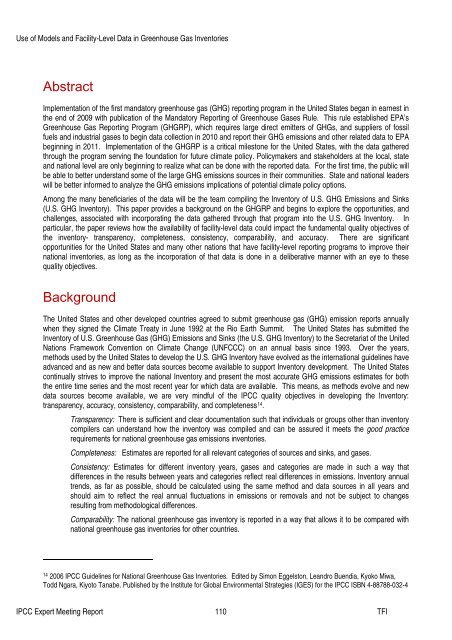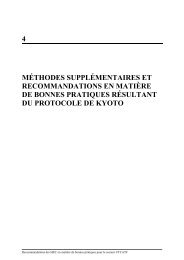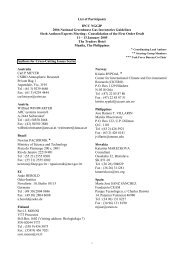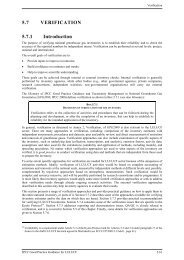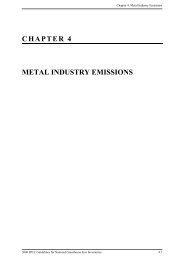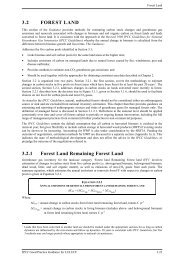Use of Models and Facility-Level Data in Greenhouse Gas Inventories
Use of Models and Facility-Level Data in Greenhouse Gas Inventories
Use of Models and Facility-Level Data in Greenhouse Gas Inventories
You also want an ePaper? Increase the reach of your titles
YUMPU automatically turns print PDFs into web optimized ePapers that Google loves.
<strong>Use</strong> <strong>of</strong> <strong>Models</strong> <strong>and</strong> <strong>Facility</strong>-<strong>Level</strong> <strong>Data</strong> <strong>in</strong> <strong>Greenhouse</strong> <strong>Gas</strong> <strong>Inventories</strong><br />
Abstract<br />
Implementation <strong>of</strong> the first m<strong>and</strong>atory greenhouse gas (GHG) report<strong>in</strong>g program <strong>in</strong> the United States began <strong>in</strong> earnest <strong>in</strong><br />
the end <strong>of</strong> 2009 with publication <strong>of</strong> the M<strong>and</strong>atory Report<strong>in</strong>g <strong>of</strong> <strong>Greenhouse</strong> <strong>Gas</strong>es Rule. This rule established EPA’s<br />
<strong>Greenhouse</strong> <strong>Gas</strong> Report<strong>in</strong>g Program (GHGRP), which requires large direct emitters <strong>of</strong> GHGs, <strong>and</strong> suppliers <strong>of</strong> fossil<br />
fuels <strong>and</strong> <strong>in</strong>dustrial gases to beg<strong>in</strong> data collection <strong>in</strong> 2010 <strong>and</strong> report their GHG emissions <strong>and</strong> other related data to EPA<br />
beg<strong>in</strong>n<strong>in</strong>g <strong>in</strong> 2011. Implementation <strong>of</strong> the GHGRP is a critical milestone for the United States, with the data gathered<br />
through the program serv<strong>in</strong>g the foundation for future climate policy. Policymakers <strong>and</strong> stakeholders at the local, state<br />
<strong>and</strong> national level are only beg<strong>in</strong>n<strong>in</strong>g to realize what can be done with the reported data. For the first time, the public will<br />
be able to better underst<strong>and</strong> some <strong>of</strong> the large GHG emissions sources <strong>in</strong> their communities. State <strong>and</strong> national leaders<br />
will be better <strong>in</strong>formed to analyze the GHG emissions implications <strong>of</strong> potential climate policy options.<br />
Among the many beneficiaries <strong>of</strong> the data will be the team compil<strong>in</strong>g the Inventory <strong>of</strong> U.S. GHG Emissions <strong>and</strong> S<strong>in</strong>ks<br />
(U.S. GHG Inventory). This paper provides a background on the GHGRP <strong>and</strong> beg<strong>in</strong>s to explore the opportunities, <strong>and</strong><br />
challenges, associated with <strong>in</strong>corporat<strong>in</strong>g the data gathered through that program <strong>in</strong>to the U.S. GHG Inventory. In<br />
particular, the paper reviews how the availability <strong>of</strong> facility-level data could impact the fundamental quality objectives <strong>of</strong><br />
the <strong>in</strong>ventory- transparency, completeness, consistency, comparability, <strong>and</strong> accuracy. There are significant<br />
opportunities for the United States <strong>and</strong> many other nations that have facility-level report<strong>in</strong>g programs to improve their<br />
national <strong>in</strong>ventories, as long as the <strong>in</strong>corporation <strong>of</strong> that data is done <strong>in</strong> a deliberative manner with an eye to these<br />
quality objectives.<br />
Background<br />
The United States <strong>and</strong> other developed countries agreed to submit greenhouse gas (GHG) emission reports annually<br />
when they signed the Climate Treaty <strong>in</strong> June 1992 at the Rio Earth Summit. The United States has submitted the<br />
Inventory <strong>of</strong> U.S. <strong>Greenhouse</strong> <strong>Gas</strong> (GHG) Emissions <strong>and</strong> S<strong>in</strong>ks (the U.S. GHG Inventory) to the Secretariat <strong>of</strong> the United<br />
Nations Framework Convention on Climate Change (UNFCCC) on an annual basis s<strong>in</strong>ce 1993. Over the years,<br />
methods used by the United States to develop the U.S. GHG Inventory have evolved as the <strong>in</strong>ternational guidel<strong>in</strong>es have<br />
advanced <strong>and</strong> as new <strong>and</strong> better data sources become available to support Inventory development. The United States<br />
cont<strong>in</strong>ually strives to improve the national Inventory <strong>and</strong> present the most accurate GHG emissions estimates for both<br />
the entire time series <strong>and</strong> the most recent year for which data are available. This means, as methods evolve <strong>and</strong> new<br />
data sources become available, we are very m<strong>in</strong>dful <strong>of</strong> the IPCC quality objectives <strong>in</strong> develop<strong>in</strong>g the Inventory:<br />
transparency, accuracy, consistency, comparability, <strong>and</strong> completeness 14 .<br />
Transparency: There is sufficient <strong>and</strong> clear documentation such that <strong>in</strong>dividuals or groups other than <strong>in</strong>ventory<br />
compilers can underst<strong>and</strong> how the <strong>in</strong>ventory was compiled <strong>and</strong> can be assured it meets the good practice<br />
requirements for national greenhouse gas emissions <strong>in</strong>ventories.<br />
Completeness: Estimates are reported for all relevant categories <strong>of</strong> sources <strong>and</strong> s<strong>in</strong>ks, <strong>and</strong> gases.<br />
Consistency: Estimates for different <strong>in</strong>ventory years, gases <strong>and</strong> categories are made <strong>in</strong> such a way that<br />
differences <strong>in</strong> the results between years <strong>and</strong> categories reflect real differences <strong>in</strong> emissions. Inventory annual<br />
trends, as far as possible, should be calculated us<strong>in</strong>g the same method <strong>and</strong> data sources <strong>in</strong> all years <strong>and</strong><br />
should aim to reflect the real annual fluctuations <strong>in</strong> emissions or removals <strong>and</strong> not be subject to changes<br />
result<strong>in</strong>g from methodological differences.<br />
Comparability: The national greenhouse gas <strong>in</strong>ventory is reported <strong>in</strong> a way that allows it to be compared with<br />
national greenhouse gas <strong>in</strong>ventories for other countries.<br />
14<br />
2006 IPCC Guidel<strong>in</strong>es for National <strong>Greenhouse</strong> <strong>Gas</strong> <strong>Inventories</strong>. Edited by Simon Eggelston, Le<strong>and</strong>ro Buendia, Kyoko Miwa,<br />
Todd Ngara, Kiyoto Tanabe. Published by the Institute for Global Environmental Strategies (IGES) for the IPCC ISBN 4-88788-032-4<br />
IPCC Expert Meet<strong>in</strong>g Report 110 TFI


